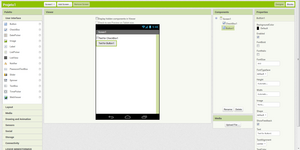How To Code An App To Make Balls Bounce Against One Another On Mit Inventor
web application integrated development environment
 | |
 MIT App Inventor | |
| Original author(s) | Hal Abelson, Mark Friedman |
|---|---|
| Developer(s) | Google, MIT Media Lab, MIT Computer Science and Artificial Intelligence Laboratory |
| Initial release | December 15, 2010; 10 years ago (2010-12-15) |
| Stable release | nb180a / November 26, 2019; 2 years ago (2019-11-26) |
| Repository | github |
| Written in | Java, Kawa, Scheme |
| Operating system | Android |
| Available in | 19 languages |
| List of languages English, Spanish, French, Italian, Korean, Dutch, Portuguese, Brazilian Portuguese, Russian, Swedish, Simplified Chinese, Traditional Chinese, Polish | |
| Type | Application software development IDE |
| License | Creative Commons Attribution ShareAlike 3.0 Unported, Apache 2.0 |
| Website | appinventor |
MIT App Inventor is a web application integrated development environment originally provided by Google, and now maintained by the Massachusetts Institute of Technology (MIT). It allows newcomers to computer programming to create application software(apps) for two operating systems (OS): Android, and iOS, which, as of 8 July 2019[update], is in final beta testing. It is free and open-source software released under dual licensing: a Creative Commons Attribution ShareAlike 3.0 Unported license, and an Apache License 2.0 for the source code.
It uses a graphical user interface (GUI) very similar to the programming languages Scratch (programming language) and the StarLogo, which allows users to drag and drop visual objects to create an application that can run on Android devices, while a App-Inventor Companion (The program that allows the app to run and debug on) that works on iOS running devices are still under development. In creating App Inventor, Google drew upon significant prior research in educational computing, and work done within Google on online development environments.[1]
App Inventor and the other projects are based on and informed by constructionist learning theories, which emphasize that programming can be a vehicle for engaging powerful ideas through active learning. As such, it is part of an ongoing movement in computers and education that began with the work of Seymour Papert and the MIT Logo Group in the 1960s, and has also manifested itself with Mitchel Resnick's work on Lego Mindstorms and StarLogo.[1] [2]
App Inventor also supports the use of cloud data via an experimental Firebase#Firebase Realtime Database component.[3]
History [edit]
The application was made available through request on July 12, 2010, and released publicly on December 15, 2010. The App Inventor team was led by Hal Abelson[1] and Mark Friedman.[4] In the second half of 2011, Google released the source code, terminated its server, and provided funding to create The MIT Center for Mobile Learning, led by App Inventor creator Hal Abelson and fellow MIT professors Eric Klopfer and Mitchel Resnick.[5] The MIT version was launched in March 2012.[6]
On December 6, 2013 (the start of the Hour of Code),[6] MIT released App Inventor 2, renaming the original version "App Inventor Classic"[7] Major differences are:
- The blocks editor in the original version ran in a separate Java process, using the Open Blocks Java library for creating visual blocks programming languages and programming

App Inventor Classic Blocks Editor
Open Blocks is distributed by MIT's Scheller Teacher Education Program (STEP) and is derived from master's thesis research by Ricarose Roque. Professor Eric Klopfer and Daniel Wendel of the Scheller Program supported the distribution of Open Blocks under an MIT License.[2] Open Blocks visual programming is closely related to StarLogo TNG, a project of STEP, and Scratch, a project of the MIT Media Lab's Lifelong Kindergarten Group led by Mitchel Resnick. App Inventor 2[7] replaced Open Blocks with Blockly, a blocks editor that runs within a web browser.
The MIT AI2 Companion app[8] enables real-time debugging on connected devices via Wi-Fi, or Universal Serial Bus (USB). In addition to this the user may use an "on computer" emulator available for Windows, MacOS, and Linux.
See also [edit]
- Android software development
- Logo (programming language)
- Lego Mindstorms
- HyperNext
- Windows Phone App Studio
References [edit]
- ^ a b c Hardesty, Larry (August 19, 2010). "The MIT roots of Google's new software". MIT News Office.
- ^ a b "On the Shoulders of Giants!". Archived from the original on August 11, 2010. Retrieved August 10, 2010.
- ^ "The FirebaseDB Component (Experimental)". ai2.appinventor.mit.edu . Retrieved 2019-02-14 .
- ^ Wolber, David; Abelson, Hal; Spertus, Ellen; Looney, Liz (May 2011), App Inventor for Android: Create Your Own Android Apps , O'Reilly, ISBN978-1-4493-9748-7
- ^ "App Inventor @ MIT".
- ^ a b Clark, Andrew (December 30, 2013), "App Inventor launches second iteration", MIT News , retrieved 7 July 2019
- ^ a b App Inventor Classic, December 3, 2013
- ^ "MIT AI2 Companion". May 25, 2019. Retrieved 8 July 2019.
External links [edit]
- Official website
- App Inventor on GitHub
- Tutorials and Sample Apps
How To Code An App To Make Balls Bounce Against One Another On Mit Inventor
Source: https://en.wikipedia.org/wiki/App_Inventor_for_Android
Posted by: hopkinshodauld.blogspot.com

0 Response to "How To Code An App To Make Balls Bounce Against One Another On Mit Inventor"
Post a Comment